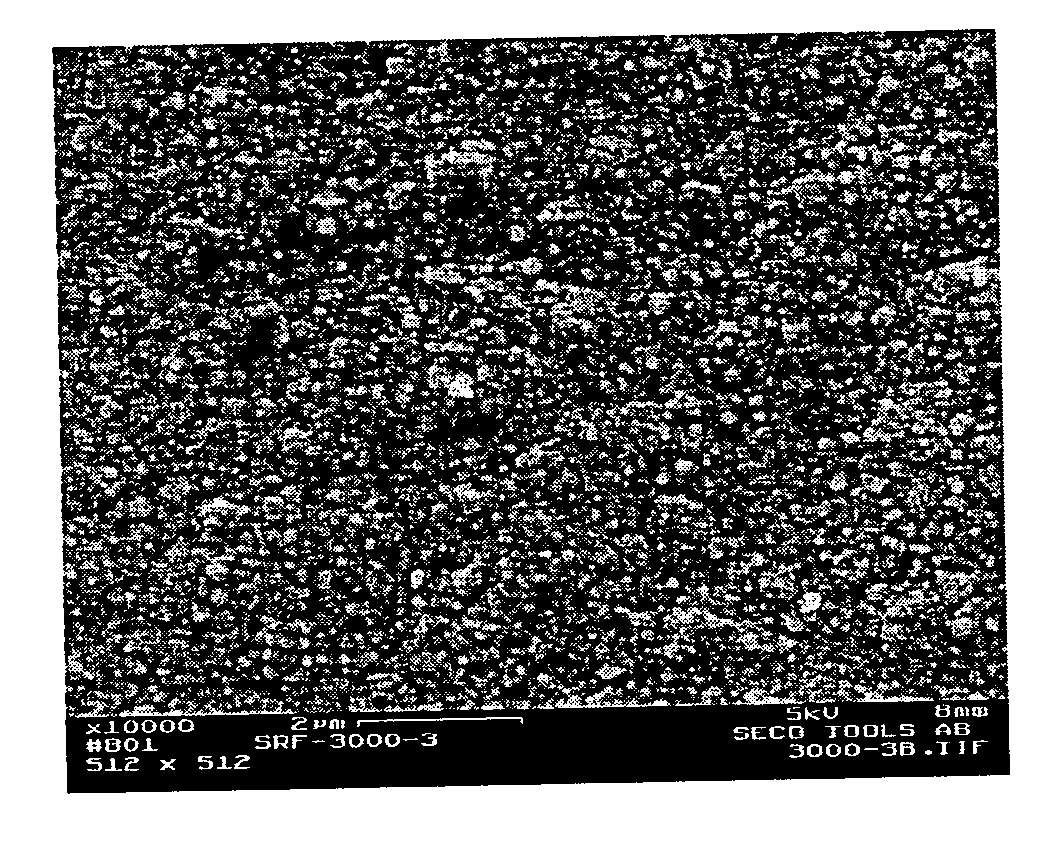Coating with controlled grain size and morphology for enhanced wear resistance and toughness
a technology of morphology and grain size, applied in the direction of chemical vapor deposition coating, magnetic recording, pigmenting treatment, etc., can solve the problems of increased toughness of coatings, difficult to modify by conventional process adjustments, and inability to meet the requirements of hard and brittle materials with limited plasticity,
- Summary
- Abstract
- Description
- Claims
- Application Information
AI Technical Summary
Benefits of technology
Problems solved by technology
Method used
Image
Examples
example 1
[0047] This example demonstrates the effect of CO doping. CO doping was applied to obtain columnar and equiaxed structures with reduced and controlled grain sizes. The following four experimental coatings (referred to as coatings 1, 2, 3 and 4 ) were produced at a pressure of 70 m bar and at a temperature of 880.degree. C. according to the process data given in Table 2. Compared with the U.S. Pat. No. 6,472,060, considerably lower amounts of doping were used except coating 4, which was produced according to prior art (U.S. Pat. No. 6,472,060). Coating 2 is deposited at a CO level of 0.8% and is composed of fine-grained columnar crystals. Coating 3 was deposited at CO doping level of 2.5% and is composed of equiaxed grains. In order to obtain equiaxed grain morphology above the nanograined region CO doping in the range of from about 2.0 to about 4.0%, preferably from about 2 to about 3% of the total gas flow can be used. The CO addition had to be controlled carefully so that the nano...
example 2
[0048] The coatings were investigated using Transmission electron microscopy (TEM) and Scanning electron microscopy (SEM) in order to elucidate the effect of CO doping on the grain size and morphology. It appeared clear even in SEM that the microstructure of the typical MTCVD Ti(C,N) coating being composed of large columnar crystals (FIG. 1) can be refined by CO doping. The equiaxed grain morphology was obtained at CO doping level of from about 2.5% (FIG. 2). TEM revealed that at this CO level the grain size was not brought into the nanograined region and was about 60 nm. The grain size of Coating 4 deposited according to prior-art was in the nanograined region. The results are summarized in Table 3.
3 TABLE 3 Grain size*) Morphology Coating 1 1500 .times. 4000 nm Large columnar Coating 2 90 .times. 650 nm Needle-like Coating 3 60 nm Small-equiaxed Coating 4 14 nm Nanograined
example 3
[0049] This example demonstrates the deposition of equiaxed grain morphology with controlled grain sizes. The effects of ZrCl.sub.4 and AlCl.sub.3 on the grain size and morphology with and without CO / CO.sub.2 doping are demonstrated.
4TABLE 4 H.sub.2 N.sub.2 CH.sub.3CN TiCl.sub.4 ZrCl.sub.4 (1 / min) (1 / min) (1 / min) (1 / min) (%) AlCl.sub.3(%) CO.sub.2(%) CO(%) Coating 5 balance 45.5 0.55 2.1 2.5 0.0 0.0 0.0 Coating 6 balance 45.5 0.55 2.1 0.7 0.0 0.0 2.1 Coating 7 balance 45.5 0.55 2.1 0.0 1.5 0.0 3.0 Coating 8 balance 45.5 0.55 2.1 0.0 3.0 0.2 3.0 Coating 9 balance 45.5 0.55 2.1 2.5 0.0 0.2 3.0 Coating 10 balance 45.5 0.55 2.1 2.5 3.0 0.2 3.0
[0050] The structure of coating 5 is shown in FIG. 3. The first part (about 2 um) was deposited without ZrCl.sub.4 doping. As very clear from the FIG. 4 the addition of 2.5% of ZrCl.sub.4 changed the coating morphology from columnar to equiaxed one (arrowed). Lower additions of ZrCl.sub.4 are needed to obtain the same structure as in Coating 5, if ...
PUM
| Property | Measurement | Unit |
|---|---|---|
| grain size | aaaaa | aaaaa |
| thickness | aaaaa | aaaaa |
| thickness | aaaaa | aaaaa |
Abstract
Description
Claims
Application Information
 Login to View More
Login to View More - R&D
- Intellectual Property
- Life Sciences
- Materials
- Tech Scout
- Unparalleled Data Quality
- Higher Quality Content
- 60% Fewer Hallucinations
Browse by: Latest US Patents, China's latest patents, Technical Efficacy Thesaurus, Application Domain, Technology Topic, Popular Technical Reports.
© 2025 PatSnap. All rights reserved.Legal|Privacy policy|Modern Slavery Act Transparency Statement|Sitemap|About US| Contact US: help@patsnap.com



